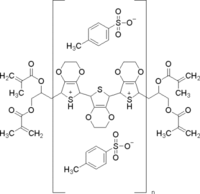- PEDOT-TMA
-
PEDOT-TMA  Other namesOligotron; Pedot tetramethacrylate; Poly(3,4-ethylenedioxythiophene), tetramethacrylate end-capped
Other namesOligotron; Pedot tetramethacrylate; Poly(3,4-ethylenedioxythiophene), tetramethacrylate end-cappedProperties Molar mass ~6000 g/mol  (verify) (what is:
(verify) (what is:  /
/ ?)
?)
Except where noted otherwise, data are given for materials in their standard state (at 25 °C, 100 kPa)Infobox references Poly(3,4-ethylenedioxythiophene)-tetramethacrylate or PEDOT-TMA is a p-type conducting polymer based on 3,4-ethylenedioxylthiophene or the EDOT monomer. It is a modification of the PEDOT structure. Advantages of this polymer relative to PEDOT (or PEDOT:PSS) are that it is dispersible in organic solvents, and it is non-corrosive. PEDOT-TMA was developed under a contract with the National Science Foundation, and it was first announced publicly on April 12, 2004 [1]. The trade name for PEDOT-TMA is Oligotron. PEDOT-TMA was featured in an article entitled "Next Stretch for Plastic Electronics" that appeared in Scientific American in 2004 [2]. It was also featured in an article entitled "Light, and magic" in the Materials Science section of The Economist [3]. The U.S. Patent office issued a patent protecting PEDOT-TMA on April 22, 2008 [4].
PEDOT-TMA differs from the parent polymer PEDOT in that it is capped on both ends of the polymer. This limits the chain-length of the polymer, making it more soluble in organic solvents than PEDOT. The methacrylate groups on the two end-caps allow further chemistry to occur such as cross-linking to other polymers or materials.
Application Overview
Several devices and materials have been described in both journals and the patent literature that use PEDOT-TMA as a critical component. In this section, a brief overview of these inventions is given.
- Patternable OLED's: In a study [5] by researchers at General Electric, PEDOT-TMA was used in the hole injection layer in a series of OLED devices. They have also filed a patent application to protect this invention [6].
- Ion Selective Membranes: PEDOT-TMA was used as a key ingredient in ion selective membranes [7].
- Dye Sensitized Solar Cell: PEDOT-TMA was used in the construction of an effective Dye-sensitized solar cell [8].
- Flexible Touch Screens: PEDOT-TMA was used in the construction of electrodes for flexible touch screens as described in a patent application by the Honeywell Corporation [9].
- Energy Storage and Conversion Devices: Synkera Technologies, Inc. filed a patent application detailing a variety of energy storage and conversion devices that use PEDOT-TMA in their construction [10].
- Glucose Sensor: A glucose sensor was prepared by Gymama Slaughter of Virginia State University [11].
- Carbon Nanotube Composites: Researchers from Los Alamos National Laboratory used PEDOT-TMA to prepare composites with carbon nanotubes. These composites form highly aligned arrays of the nanotubes, and exhibit high conductivity at room temperature (25.0 S/cm)[12].
References
- ^ J. Chamot. "New Molecule Heralds Breakthrough in Electronic Plastics," 4/12/2004. http://www.nsf.gov/news/news_summ.jsp?cntn_id=100360
- ^ G. P. Collins. "Next Stretch for Plastic Electronics." Scientific American, July 2004, p. 75-81.
- ^ The Economist, May 22, 2004; p. 74.
- ^ Elliott; Brian J., Ellis; William W., Luebben; Silvia D., Sapp; Shawn A., Chang; Chieh-Hui, D'Sa; Raechelle A. "Electrically conducting materials from branched end-capping intermediates," United States Patent 7,361,728.
- ^ J. Liu, L. N. Lewis and A. R. Dugal. "Photoactivated and patternable charge transport materials and their use in organic light-emitting devices." Appl. Phys. Lett. 90, 233503 (2007) http://dx.doi.org/10.1063/1.2746404
- ^ Jie Liu, Larry Neil Lewis, Anil Raj Duggal, Rubinsztajn Slawomir. "Organic light emitting devices having latent activated layers and methods of fabricating the same." US 2007/0077452 A1, Oct 4, 2005.
- ^ Anna Rzewuska, Marcin Wojciechowski, Ewa Bulska, Elizabeth A. H. Hall, Krzysztof Maksymiuk, and Agata Michalska. "Composite Polyacrylate-Poly(3,4- ethylenedioxythiophene) Membranes for Improved All-Solid-State Ion-Selective Sensors." Anal. Chem., 80 (1), 321 -327, 2008.
- ^ Kyung Ho Kim, Takashi Okubo, Naoyo Tanaka, Naoto Mimura, Masahiko Maekawa and Takayoshi, Kuroda-Sowa. "Dye-sensitized Solar Cells with Halide-bridged Mixed-valence Cu(I)-Cu(II) Coordination Polymers with Hexamethylenedithiocarbamate Ligand." Chem. Lett., 39 (7), 792-793, 2010.
- ^ Lewin Edwards, Patricia McCrimmon, and Richard Thomas Watson. "Tactile-Feedback Touch Screen." US 2010/0182245 A1, Jul. 22, 2010.
- ^ Dmitri Routkevitch, and Rikard A. Wind. "Energy Conversion and Energy Storage Devices and Methods for Making Same." US 2010/0304204 A1, Dec. 2, 2010.
- ^ Gymama Slaughter. "Fabrication of Nanoindented Electrodes for Glucose Detection." J Diabetes Sci Technol. 2010 March; 4(2): 320–327.
- ^ Huisheng Peng and Xuemei Sun. "Highly Aligned Carbon Nanotube/Polymer Composites with Much Improved Electrical Conductivities." Chemical Physics Letters 471 (2009), 103-5.
Categories:- Organic polymers
- Organic semiconductors
- Conductive polymers
- Transparent electrodes
- Sensors
- Materials science
- Carboxylate esters
- Sulfur heterocycles
Wikimedia Foundation. 2010.
